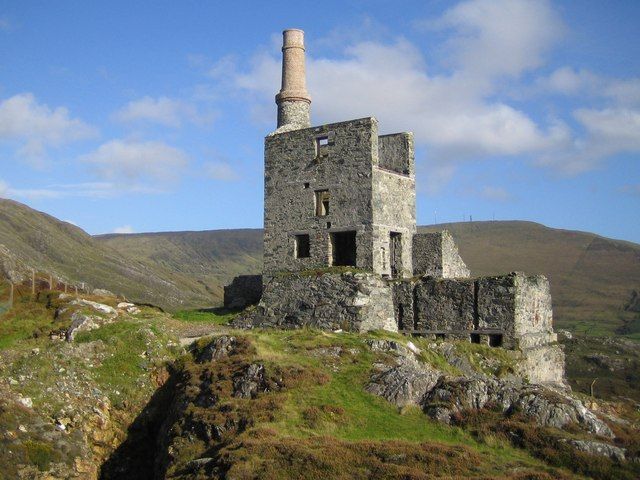
Mountain Mine, Berehaven
Copyright © Nigel Cox and licensed for reuse under this Creative Commons Licence
John Lavallin Puxley formed the Allihies Mining Company in 1812. The first Mine Captain, Edward Nettle, was a Cornishman and he started work at Dooneen, where a quartz vein extends into the sea. The Mountain (or North) Mine, was opened a year later working the veins from the surface.
Edward Nettle was dismissed in 1815, and was replaced by Richard Martin and John Reed. By 1818, the Dooneen mine was failing due to the problems they were having with water flooding the workings. Work began at Caminches, to the east of Allihies village. Two engine houses, one of which contained 36 inch steam engine stood here, but there is very little to be seen today. A steam engine for the Dooneen mine was purchased from Cornwall and delivered in September 1823.
An engine house was built at the Moutain Mine in 1830 to house a pump to dewater the mine. The shaft here eventually reached a depth of 1380 feet, with over 800 feet of this below sea level.
Production ceased at the Dooneen mine in 1838, and the Captain, Mark Reed, returned to Wheal Vor mine (near Helston) in Cornwall.
In 1862, a new pumping-engine house at Mountain mine was built, and a steam-engine powering a man-engine was installed.
Puxley sold his interest in the mines in 1868. The new mine manager was now Captain James W. Crase. Dooneen mine was re-opened in 1870 and finally abandoned in 1878, and Coom mine was reopened. A new mine was opened, Tragh na Mban, but the mines were still losing money.
The mines struggled on, but the closure of the Mountain Mine in 1882 signalled the end. The company was wound up in 1884.
Further information:
Further reading:
- Willams, R.A. The Berehaven Copper Mines (British Mining No.42, 1991)

